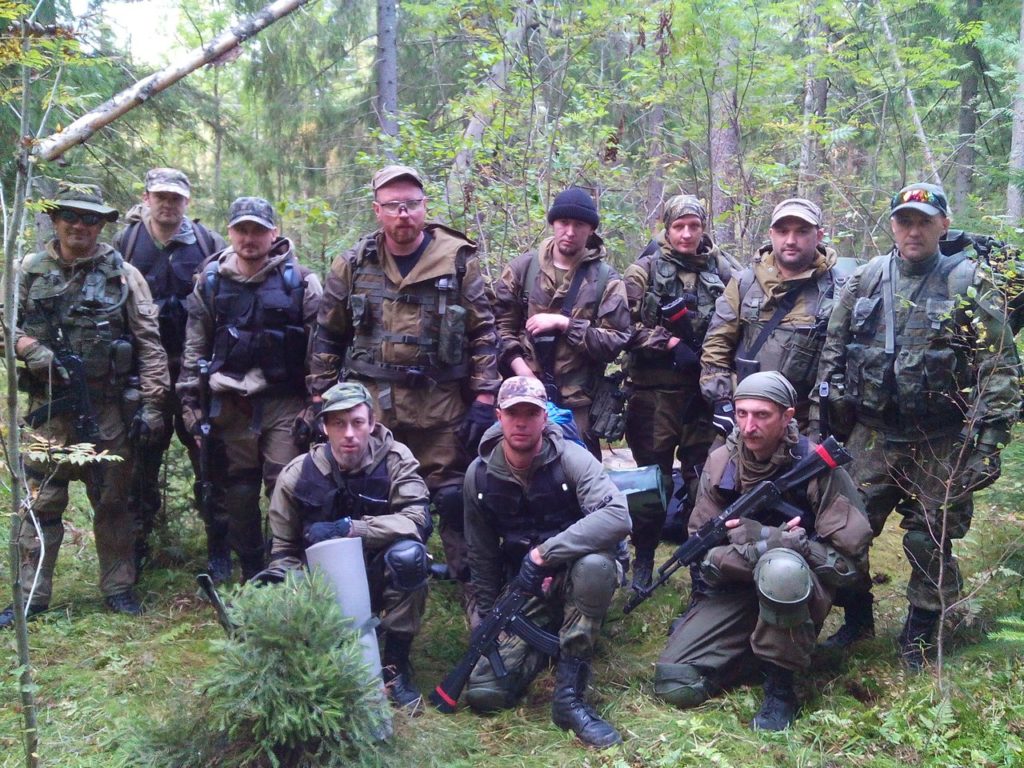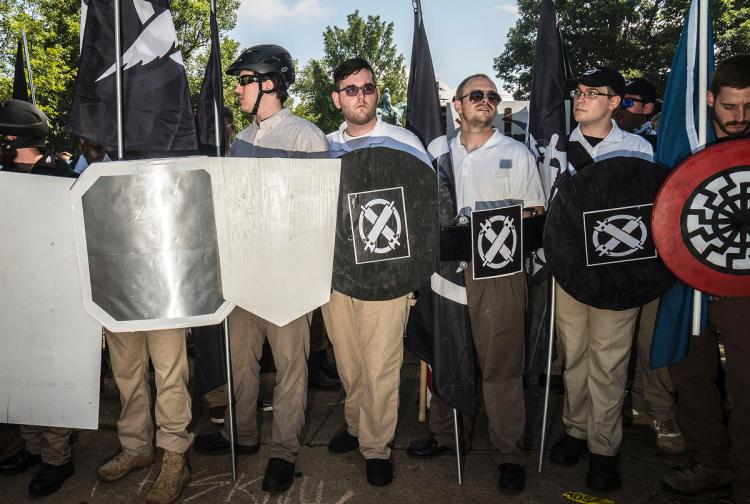Five years ago, I already wrote about the extreme-right Russian Imperial Movement (RIM) and the danger it posed internationally. And now, on the 6th of April this year, the US State Department designated the RIM, as well as three persons who were associated with this movement, as a Specially Designated Global Terrorists (SDGT). Explaining the State Department’s decision, Coordinator for Counterterrorism Ambassador Nathan Sales said that the RIM was “a terrorist group that provide[d] paramilitary-style training to neo-Nazis and white supremacists, and it play[ed] a prominent role in trying to rally likeminded Europeans and Americans into a common front against their perceived enemies”. Furthermore, Ambassador Sales noted that the RIM provided paramilitary training to Swedish persons who would, a few months later, become involved in a series of terrorist attacks in Gothenburg. Ambassador Sales also reminded that the RIM “was among the forces that [had] fought in Ukraine on behalf of the pro-separatist forces”. (I wrote about the RIM and the danger it posed five years ago.)
The State Department’s decision to designate the RIM as a SDGT is unprecedented: it is the first foreign extreme-right organization that was included in the list of SDGTs. This development is a result of the discussions about right-wing terrorism that intensified in the US after a series of troubling cases of extreme-right attacks in the US and around the world, and this article reflects upon some of these discussions.

Participants of the RIM’s “Partisan” military courses, Russia, September 2015
On the 12th of February this year, the US House Committee on Homeland Security advanced the Transnational White Supremacist Extremism Review Act introduced by Congressman Max Rose, a decorated veteran of the war in Afghanistan. If adopted, the bill will “direct the Under Secretary for Intelligence and Analysis of the Department of Homeland Security to develop and disseminate a threat assessment regarding threats to the United States associated with foreign violent white supremacist extremist organizations”.
This is, indeed, a welcome initiative considering the rise of right-wing terrorism across the Western world. In 2019, an Australian neo-Nazi terrorist killed 51 and injured 49 people in what has become known as the Christchurch mosque shootings. The same year, an American far-right terrorist shot 22 and wounded 24 people at a Walmart store in El Paso, Texas. Also in 2019, a German member of the transnational neo-Nazi terrorist movement Combat 18 assassinated a German center-right politician Walter Lübcke, while already this year a German neo-Nazi killed 11 and injured five people at two shisha bars in Hanau.
According to the Global Terrorism Index 2019 published by the US-based Institute for Economics & Peace, far-right terrorism, while remaining “a small fraction of total terrorism worldwide”, has been increasing in Western Europe, North America and Oceania. The Index provides us with the frightening statistics: over the past five years, the total number of right-wing terrorist attacks have increased by 320%.
Despite the very clear dangers that far-right terrorism poses to Western societies, no right-wing extremist organization – until very recently – has been designated as an SDGT or a Foreign Terrorist Organization (FTO) by the US State Department that lists dozens of primarily Islamist, but also far-left and separatist, organizations and movements as FTOs. Fortunately, the discussion now moves in the right direction, and the National Strategy for Counterterrorism endorsed by President Donald Trump in 2018 does mention two overseas neo-Nazi organizations.
Max Rose’s proposed bill is yet another important contribution to the discussion. However, one can identify three potentially problematic aspects related to the bill itself and its implementation.
The bill defines “a foreign violent white supremacist extremist organization” – a concept at the core of the bill – as “an organization based outside the United States that seeks, wholly or in part, through unlawful acts of force or violence, to support a belief in the intellectual and moral superiority of the white race over other races”.
The first problematic aspect is that, in stark contrast to the instances of far-left and separatist terrorism, acts of far-right terrorism are carried out predominantly by people only loosely, if at all, affiliated with specific right-wing extremist organizations. The classical example here is the Norwegian neo-Nazi terrorist Anders Breivik, who carried out the second deadliest terrorist attack in history since the Bologna massacre in 1980 and yet was not a member of any political organization. Given the peculiarities of right-wing extremism and social behavior of far-right activists, much more attention should be paid to online resources that facilitate radicalization of individuals. The bill does mention online platforms, as it suggests that “appropriate owners and operators of online platforms” need to provide assistance “in identifying content that may be associated with a foreign violent white supremacist extremist organization”, but here, again, the focus is on far-right organizations, rather than online resources, which may be right-wing extremist by nature but still not associated with any organization.
Furthermore, despite attempts by some Western authorities to police social networks and other online platforms, these attempts are often belated. For example, the American company GoDaddy Inc. cancelled the registration of the American extreme-right website Daily Stormer only after the founder of the website publicly endorsed the murderous right-wing attack on a protester at the “Unite the Right” rally in Charlottesville in 2017, while the American company Cloudflare Inc. would continue providing its services to Daily Stormer after the website was forced to move to a Russian domain registrar. Nevertheless, while it is technically impossible to cut right-wing extremists from the Internet, cancelling their accounts on the major social networks such as Facebook, Twitter, Instagram or YouTube does impede their endeavors to raise money online for their cause, as the cases of far-right figures Milo Yiannopoulos and Stephen Christopher Yaxley-Lennon (better known as Tommy Robinson) permanently banned on the major social networks demonstrate.

Neo-Nazis during the “Unite the Right” march in Charlottesville on 12 August 2017. A man in the centre is James Fields who killed one and injured 19 counter-protestors.
The second problematic aspect is that the perspective on right-wing extremism adopted in the bill is too American. While it may appropriately reflect the realities in the US, it is likely to fail to do so in the broader Western context, which is crucial since the act is about foreign, rather than American, organizations. Two points here. First, the term “white supremacism” implies the indisputability of the concept of white race, which is not the case in many Western countries, while far-right hate crimes may be underpinned by ethnic or national, rather than racial, considerations. Second, if we are talking about “unlawful acts of force or violence” informed by “a belief in the intellectual and moral superiority of the white race over other races”, then we leave out a great number of dangerous right-wing extremist organizations that may engage in acts of terrorism not against perceived “non-white” people, but against political opponents (liberal or left-wing politicians or activists), as well as against the LGBT community. Hence, it would perhaps be useful to refer not to “white supremacist extremist organizations”, but to “right-wing extremist organizations”.
The third potentially problematic aspect is connected to the implementation of the bill. What right-wing extremist organizations can be designated as FTOs? A number of texts (co-)written by Congressman Max Rose as part of his argument in favor of the Transnational White Supremacist Extremism Review Act produce a controversial picture. For example, Rose’s letter to the Secretary of State Michael Pompeo (signed, in addition, by other 39 Members of Congress) and the New York Times op-ed (co-authored by Rose and former Federal Bureau of Investigation special agent Ali H. Soufan) correctly indicate some right-wing terrorist organizations, misidentify as such another organization, and miss some obvious cases.
The two texts are right to consider the British National Action and Scandinavian Nordic Resistance Movement (NRM) as terrorist organizations. National Action glorified the assassination of the UK’s MP Jo Cox by a British neo-Nazi and incited further violence against politicians. Several members of the NRM were engaged in a series of bombings and attempted bombings targeting left-wing activists and a refugee residence. A British neo-Nazi who murdered Jo Cox had links to the American far right, while two out of three NRM’s convicted bombers received explosive-ordnance training at a paramilitary camp organized by the RIM already designated as a SDGT.

Swedish neo-Nazis from the Nordic Resistance movement Anton Thulin (first from the left) and Viktor Melin (second from the left) at the Partisan military camp organized by the RIM.
However, the two documents incorrectly identify as a suspected FTO the Ukrainian “Azov Battalion”, which is – rather than being a “paramilitary unit” or a “militia organization”, as the texts erroneously assume – is an official regiment of the Ukrainian National Guard that is part of Ukraine’s Ministry of Internal Affairs the orders of which the regiment follows.
At the same time, the documents do not mention the evidently terrorist Blood & Honour network or Combat 18 group. The two originated in the UK, but over the years had chapters established across the Western world. Numerous cases of right-wing terrorism and other forms of ideologically driven political violence were and still are associated with members of these movements. Canada listed both as terrorist entities in 2019, and Germany banned Combat 18 nationwide in the beginning of 2020. It is high time the US did the same.
Congressman Max Rose’s legislative initiative can become a serious contribution to the international fight against right-wing extremism that has become increasingly transnational. However, this initiative would benefit from elaboration of the concepts it uses, as well as further consideration of its potential targets.